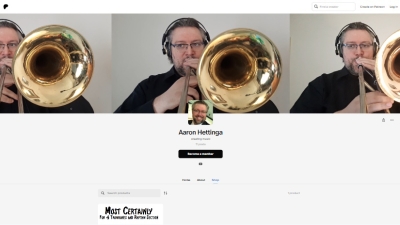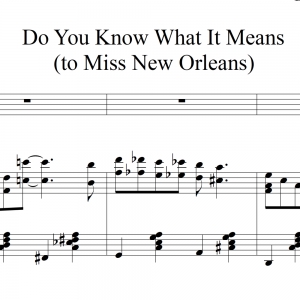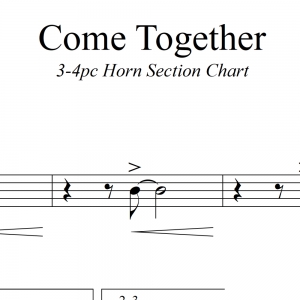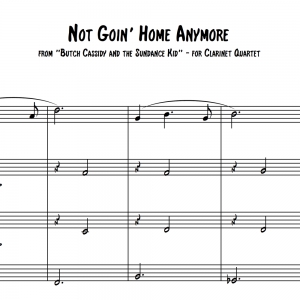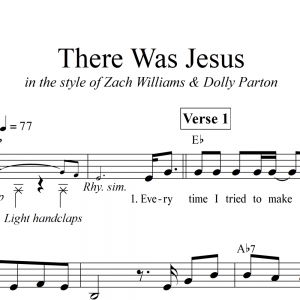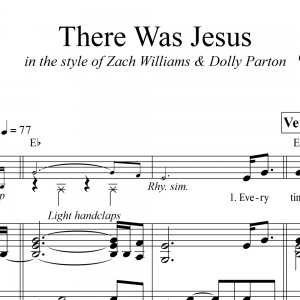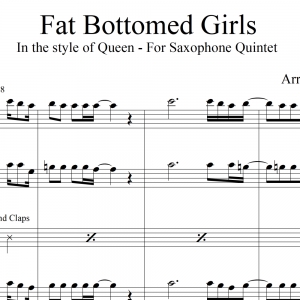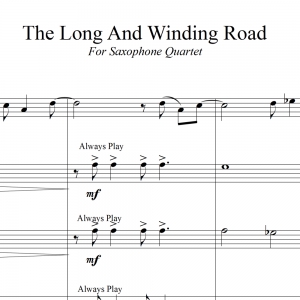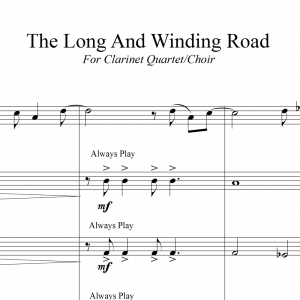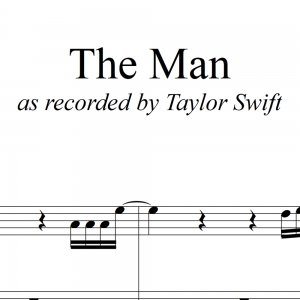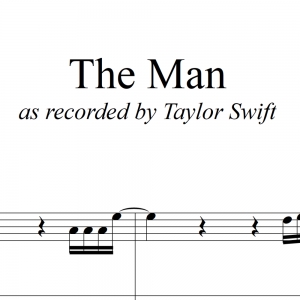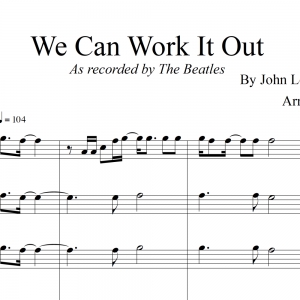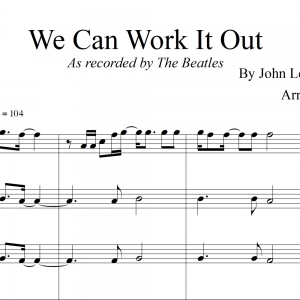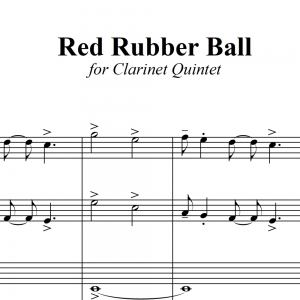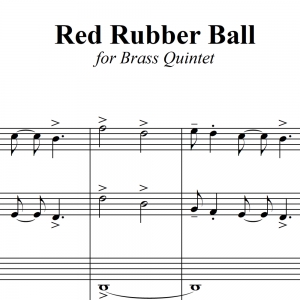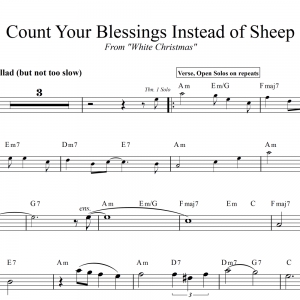
Aaron Hettinga
This Mardi Gras classic is presented here in a flexible arrangement for Instrumental Solo with Piano accompaniment in the key of C. Four transpositions of the soloist’s part are included to allow for any instrumentalist to utilize this arrangement. The form is AABA plus a BA repeated section with a tag. Chord changes are included above the melody line to allow soloists the freedom to improvise, especially from measure 37 on.
A good vehicle to showcase an instrumentalist with a great standard!
Also available for Traditional Jazz Ensemble or Piano/Vocal/Guitar or Brass Quintet
This arrangement of this Beatles classic gives a horn section a chance to fill up a performance of “Come Together." This horn chart follows the key and form of the original track to bring some extra punch to the rhythm section. The Bari Sax part is Optional. Really lifts up a live performance!
None of the parts should pose much of a challenge for even young players.
This fun classic rock anthem from Queen is presented here for Wind Quintet. The form of the original recording is closely followed but does not include the extended guitar solo playout, skipping ahead to the last three punctuated ending hits. This arrangement is one whole step lower than the record.
Flexibility: This arrangement includes an optional (but encouraged) drum kit part. While the chart is constructed that it will work just fine without it, having a drummer on board will kick this one up a notch.
Performance options: As noted, the form of the original is mostly followed with a few “2nd time only” cues for variety, this can also be streamlined if so desired. The repeated first/second verse section near the start could jump ahead to the second ending to save time. Also, rather than following the transition back to the D.S., a group alternatively could jump straight to the coda having already covered the bulk of the song.
This holiday-season standard is available here for Saxes and Rhythm section as performed by trombonists Bill Watrous & Carl Fontana in their amazing recording. The general form and key of their original recording is followed.
This arrangement was written as a “Head” chart where, after the initial rundown of the melody, the form is repeated for as many soloists as are desired before a final repeat playing the tune and proceeding to the second ending. Chord changes are provided in all parts for flexibility in soloist selection.
Performance options: This is a flexible arrangement that can be played with anywhere from 2 to 4 Saxophonists. Parts 1 & 2 are featured as the duet throughout, but each extra part adds a few extra lines and harmonic density. The top two parts are the most involved but the other two parts will be more accessible to players with lesser experience.
Also available for Trombone ensembles
“Not Going Home Anymore” is one of the gorgeous pieces from Burt Bacharach’s score for “Butch Cassidy and the Sundance Kid.” While it should be played as a slow waltz, it’s important not to drag it too slowly. There is ample opportunity to take advantage of suspended chords in the accompaniment throughout.
Instrumentation: This piece is presented here in an arrangement for Clarinet Quartet or Clarinet Choir.
Performance notes: This arrangement will feature the melodic/legato ballad abilities of the 1st Clarinetist. The remaining parts are not too difficult for most players, but the lead will need to be a solid player. A demo recording of a similar arrangement for Trombones is embedded below.
“Not Going Home Anymore” is one of the gorgeous pieces from Burt Bacharach’s score for “Butch Cassidy and the Sundance Kid.” While it should be played as a slow waltz, it’s important not to drag it too slowly. There is ample opportunity to take advantage of suspended chords in the accompaniment throughout.
Instrumentation: This piece is presented here in an arrangement for AATB Saxophone Quartet. A Soprano Sax Sub part is included for a SATB Saxophone quartet option as well.
Performance notes: This arrangement will feature the melodic/legato ballad abilities of the 1st Alto. The remaining parts are not too difficult for most players, but the lead will need to be a solid player. A demo recording of a similar arrangement for Trombones is embedded below:
This tender recording from Zach Williams & Dolly Parton is presented here in a performance- ready lead sheet.
This lead sheet conforms to the original performance in form, but for this edition the key has been lowered to E-flat major. Vocal harmonies are cued above the full-sized notes of the melody. Dolly takes some liberties here and there, but not every inflection is notated every time.
Also available as in a package with the Piano/Vocal arrangement.
Additionally availble in the original key as a Lead Sheet or Piano/Vocal Arrangemnet
This tender recording from Zach Williams & Dolly Parton is presented here in a Piano/Vocal arrangement. The lead sheet is included with this package.
This Piano part and Lead Sheet both conform to the original performance in form, but for this edition the key has been lowered to E-flat major. Vocal harmonies are cued above the full-sized notes of the melody. Dolly takes some liberties here and there, but not every inflection is notated every time.
Also available independently with only the Lead Sheet.
Additionally availble in the original key as a Lead Sheet or Piano/Vocal Arrangemnet
This fun classic rock anthem from Queen is presented here for AATTB Saxophone Quintet. The form of the original recording is closely followed but does not include the extended guitar solo playout, skipping ahead to the last three punctuated ending hits. This arrangement is one whole step lower than the record.
Flexibility: This arrangement includes an optional (but encouraged) drum kit part. While the chart is constructed that it will work just fine without it, having a drummer on board will kick this one up a notch.
Performance options: As noted, the form of the original is mostly followed with a few “2nd time only” cues for variety, this can also be streamlined if so desired. The repeated first/second verse section near the start could jump ahead to the second ending to save time. Also, rather than following the transition back to the D.S., a group alternatively could jump straight to the coda having already covered the bulk of the song.
This fun classic rock anthem from Queen is presented here for Clarinet Quintet/Choir. The form of the original recording is closely followed but does not include the extended guitar solo playout, skipping ahead to the last three punctuated ending hits. This arrangement is one whole step lower than the record.
Flexibility: This arrangement includes an optional (but encouraged) drum kit part. While the chart is constructed that it will work just fine without it, having a drummer on board will kick this one up a notch.
Performance options: As noted, the form of the original is mostly followed with a few “2nd time only” cues for variety, this can also be streamlined if so desired. The repeated first/second verse section near the start could jump ahead to the second ending to save time. Also, rather than following the transition back to the D.S., a group alternatively could jump straight to the coda having already covered the bulk of the song.
This oldie but goodie by Cyrkle and Simon & Garfunkel is presented here in a flexible arrangement for Instrumental Solo with Piano Accompaniment. This package includes transposed parts to allow for any instrumentalist to play this song with a pianist. All of the packaged solo parts are prepared to be relatively accessible to players of even moderate ability as there are no major range challenges that are taxing to the extremes of any instrument. Alternatively, the soloist may optionally wish to play the written part an octave higher (such as for Flute or Violin). The technical challenges may come about if taken at a particularly brisk tempo, but even a slightly slower interpretation will sound great.
Performance notes: The key change is present as a tribute to the original recordings, but doesn’t play out here quite the same way. Keys better suited to band instruments are utilized instead, but it can still sneak up on you. If the performers would prefer a shorter performance, the 1st ending could be bypassed altogether.
Also available for Brass Quintet Clarinet Choir or AATTB Saxophone Quintet
This timeless classic from the Beatles is presented here in an arrangement for SATB Saxophone ensemble. It can really be considered as a solo feature for the Soprano Sax, with accompaniment provided by the other three. Aside from some of the rhythmic demands of the melody, the range is not too taxing for any of the four parts for players of an intermediate skill level. Alternatively, the Soprano Sax part could instead be played by a soloist on Tenor Sax.
Flexibility: Additionally, this entire arrangement conforms to the original artist’s recording in Key and Form. If desired, this chart could be used along with a pianist or a rhythm section if desired to fill things out a bit further.
Also available for Trombone Quartet or Clarinet Quartet/Choir
This timeless classic from the Beatles is presented here in an arrangement for four-part Clarinet ensemble. It can really be considered as a solo feature for the 1st Clarinetist, with accompaniment provided by the other three. Aside from some of the rhythmic demands of the melody, the range is not too taxing for any of the four parts for players of an intermediate skill level.
Flexibility: Additionally, this entire arrangement conforms to the original artist’s recording in Key and Form. If desired, this chart could be used along with a pianist or a rhythm section if desired to fill things out a bit further.
Also available for Trombone Quartet or SATB Saxophone Quartet
Sia's powerful song "Unstoppable" is available here arranged for performance by a SATB Saxophone Quartet. Key of G minor. Follows the form of the original recording, but transposed up ½ step to better accommodate wind instruments.
This arrangement gives interesting lines to all players. The Bari Sax part functions as the rhythm section while the melody passes back and forth between the Tenor, Alto, and Soprano parts.
Also available as a Lead Sheet, String Quartet and Clarinet Quartet/Choir
Sia's powerful song "Unstoppable" is available here arranged for performance by a Clarinet Quartet/Choir. Key of G minor. Follows the form of the original recording, but transposed up ½ step to better accommodate wind instruments.
This arrangement gives interesting lines to all players. The Bass Clarinet part functions as the rhythm section while the melody passes back and forth between the remaining three parts.
Also available as a Lead Sheet, String Quartet and SATB Saxophone Quartet
This empowering song from Taylor Swift is available here as an arrangement for String Quartet. The form and key match the original recording.
In this arrangement, all 4 string parts get the opportunity to play some active and interesting lines. The active rhythmic nature of the original song may pose a slight challenge for younger or less experienced players.
This song is also available as a Rhythm/Vocal Lead Sheet, String Quartet, and Clarinet Quartet/Choir
This empowering song from Taylor Swift is available here as an arrangement for Clarinet Quartet/Choir. The form and key match the original recording.
In this arrangement, all 4 parts get the opportunity to play some active and interesting lines. The active rhythmic nature of the original song may pose a slight challenge for younger or less experienced players.
This song is also available as a Rhythm/Vocal Lead Sheet, String Quartet, or SATB Saxophone Quartet
This Beatles classic makes for a nice little tune for unaccompanied SATB Saxophone Quartet. The form of the original recording is closely followed but has been crafted to function with a standalone ensemble without vocals or percussion. The key is raised ½ step to better accommodate wind instruments. This will make a fine addition to a Beatles tribute set or as nice background music for a wedding reception’s cocktail hour.
Performance options: If this feels as though it is going on a little long for the available performance time, taking the Coda during the repeat rather than the DS should trim off enough to make for a still complete performance of the song without taking as much time..
None of the parts should pose much of a challenge for even young players.
"We Can Work It Out" is available for:
This Beatles classic makes for a nice little tune for unaccompanied clarinet ensemble. The form of the original recording is closely followed but has been crafted to function with a standalone ensemble without vocals or percussion. The key is raised ½ step to better accommodate wind instruments. This will make a fine addition to a Beatles tribute set or as nice background music for a wedding reception’s cocktail hour.
Performance options: If this feels as though it is going on a little long for the available performance time, taking the Coda during the repeat rather than the DS should trim off enough to make for a still complete performance of the song without taking as much time..
None of the parts should pose much of a challenge for even young players.
"We Can Work It Out" is available for:
This oldie but goodie by Cyrkle and Simon & Garfunkel is presented here in an arrangement for Clarinet Ensemble. All of the parts should be relatively accessible to players of even moderate ability as there are no major range challenges that are taxing to the extremes of any instrument other than a few low notes. The technical challenges may come about if taken at a particularly brisk tempo, but even a slightly slower interpretation will sound great.
Performance notes: The key change is present as a tribute to the original recordings, but doesn’t play out here quite the same way. Keys better suited to band instruments are utilized instead, but it can still sneak up on you. If the performers would prefer a shorter performance, the 1st ending could be bypassed altogether.
Also available for Brass Quintet or AATTB Saxophone Quintet or Solo with Piano
This oldie but goodie by Cyrkle and Simon & Garfunkel is presented here in an arrangement for Saxophone Quintet. All of the parts should be relatively accessible to players of even moderate ability as there are no major range challenges that are taxing to the extremes of any instrument. The technical challenges may come about if taken at a particularly brisk tempo, but even a slightly slower interpretation will sound great.
Performance notes: The key change is present as a tribute to the original recordings, but doesn’t play out here quite the same way. Keys better suited to band instruments are utilized instead, but it can still sneak up on you. If the performers would prefer a shorter performance, the 1st ending could be bypassed altogether.
Also available for Brass Quintet or Clarinet Choir or Solo with Piano
This oldie but goodie by Cyrkle and Simon & Garfunkel is presented here in an arrangement for Brass Quintet. All of the parts should be relatively accessible to players of even moderate ability as there are no major range challenges that are taxing to the extremes of any instrument. The technical challenges may come about if taken at a particularly brisk tempo, but even a slightly slower interpretation will sound great.
Performance notes: The key change is present as a tribute to the original recordings, but doesn’t play out here quite the same way. Keys better suited to brass players are utilized instead, but it can still sneak up on you. If the performers would prefer a shorter performance, the 1st ending could be bypassed altogether.
Also available for Clarinet Choir or AATTB Saxophone Quintet or Solo with Piano
This lesser known holiday-season standard by the great Irving Berlin is available here for 4 Trombones and Rhythm section. This ballad had its debut in the classic film “White Christmas” with Bing Crosby and Rosemary Clooney.
This arrangement was written as a “Head” chart where, after the initial rundown of the melody, the form is repeated for as many soloists as are desired before a final repeat playing the tune and proceeding to the second ending. Chord changes are provided in all parts for flexibility in soloist selection.
For the most part, the ensemble parts are accessible to a broad range of playing abilities, but the top part is the greater challenge for range and melodic lyricism.
Performance options: This ballad runs the risk of dragging along so slowly that it feels interminable. Even at a moderately slow tempo, it’s important to keep things moving. If it feels that the solo section takes too long, it also works well to bring the ensemble back at the “B” section of the melody (meas. 21) for a briefer wrap up.
“Not Going Home Anymore” is one of the gorgeous pieces from Burt Bacharach’s score for “Butch Cassidy and the Sundance Kid.” While it should be played as a slow waltz, it’s important not to drag it too slowly. There is ample opportunity to take advantage of suspended chords in the accompaniment throughout.
Instrumentation: This piece is presented here in an arrangement for Trombone Quartet or Trombone Choir. Alternatively, any of the parts could be played by Euphoniums/Baritones, or the Bass Trombone line would work well on Tuba as well.
Performance notes: This arrangement will feature the melodic/legato ballad abilities as well as the range of the 1st trombonist. The remaining parts are not too difficult for most players, but the lead will need to be a solid player. A demo recording (video below) is recorded ½ step higher in pitch.



